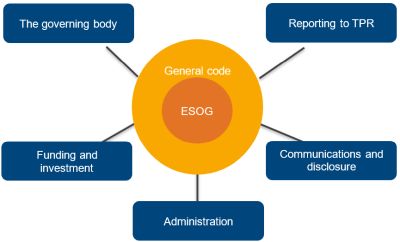It has finally arrived! After a lengthy wait, the Pensions Regulator ("TPR") has published the general code of practice (the "Code"). It is expected to come into effect on 27 March 2024. The Code applies to "governing bodies". Governing bodies are those responsible for running the scheme and include trustees or managers of an occupational pension scheme. In this update we refer, for ease, only to trustees.
In a statement following publication of the Code, TPR challenges governing bodies to use the Code "as an opportunity to ensure their scheme is fit for the 21st century".
Where did it all begin?
The Code has been in the "pipeline" for a number of years. The Code sets out TPR's expectations as to how trustees should meet their legal responsibility to have in place an "effective system of governance" ("ESOG").
As a reminder, a 2016 EU Directive1 included a requirement for the ESOG and so the UK was obliged at the time to incorporate the ESOG into UK legislation. Regulations2 were implemented which amended the Pensions Act 2004 to introduce a requirement on trustees to "establish and operate an effective system of governance including internal controls". The regulations also listed a range of matters comprising the ESOG and provided for TPR to issue a code of practice covering how it expected trustees to discharge their duties in relation to the ESOG.
It is against this backdrop that TPR has now issued the Code, which also consolidates 10 of its 15 codes of practice.
How is the Code structured?

It follows that the Code covers TPR's expectations on what needs to be done in order to comply with the ESOG in addition to covering other areas of governance.
There are five broad areas in the Code which are illustrated above. Each of these areas is broken down into sub-topics. Collectively there are 51 short topic-based modules.
Trustees will be required, under the Code, to carry out an assessment of their ESOG. This assessment is known as the own risk assessment ("ORA"). While TPR previously said that the ORA will be a significant piece of work, it now says that the ORA should be straightforward for well-run schemes.
Helpfully, the Code uses banners to flag the modules within it which fall into the ESOG requirement.
What has changed since the draft Code?
The changes are largely clarificatory, but there are some substantive changes which include the following:
- Adding references to various modules to encourage trustees to consider equality and diversity in their governance processes.
- Clarifying that the remuneration policy:
- Should only cover costs for which trustees are directly responsible.
- Does not need to set out the levels of remuneration paid.
- Does not need to be published online.
- Relaxing the timeline for the ORA preparation so that:
- Trustees will be able to complete the ORA on their own timetable (rather than all schemes having to publish an ORA on the same date).
- Trustees will be able to complete different sections of the ORA at different times, provided that the ORA is carried out in its entirety at least every three years.
- Instead of needing to be completed within 12 months of the Code coming into force, the first ORA must be completed by the deadline specified in regulations (which at its earliest will be within 12 months of the end of the first scheme year that begins after the Code comes into effect).
- Creating a standalone module for the risk management function.
- Changing some of the review timeframes. For example, the requirement to review adviser/service provider appointment policies has changed from every two years to every three years and the requirement to assess the performance of scheme investments has changed from quarterly to regularly.
- Adding high-level content in relation to requirements which came into force only after the draft Code was published. For example, the climate-related governance and reporting requirements, as well as the statutory transfer conditions.
What steps should trustees be taking?
TPR acknowledges in its consultation response that for well-run schemes the ESOG will largely be a rebranding of what trustees are already doing and proportionality will be a factor in how the ESOG is implemented.
We agree. Some trustees may have already begun work on their ESOG (for example, when the draft code was first issued) or, indeed, will already have good governance procedures in place. As such, the Code is unlikely to result major changes for them.
Steps which trustee should take (to the extent they have not already done so) include the following:
- Review the Code to gain an understanding of what it contains.
- Check current scheme policies and procedures and how/if they are documented.
- Carry out a gap analysis of current policies/procedures against the Code.
- Assess and carry out the additional work as required to comply with the ESOG and other matters in the Code.
- It might not be possible for some trustees to achieve compliance with all aspects of the Code by 27 March 2024. They may therefore wish to focus on certain modules as a priority (for example those which TPR has flagged as being ESOG areas). It would also help in such cases to put in place a plan to ensure necessary changes are implemented as soon as possible.
How can Mayer Brown help you?
We can provide trustees with the support they require to ensure their schemes are Code-compliant from 27 March 2024 and the on-going support they will require to ensure continued compliance. In particular we can:
- Provide knowledge sessions/training to get trustees up to speed with the Code – this can be high level or a bespoke session.
- Support in carrying out a scheme policies/procedures gap analysis by using our Code checklist.
- Draft, amend and/or review scheme documentation to ensure Code compliance.
Footnotes
1. EU Directive 2016/2341 (also known as 'IORP II')
2. The Occupational Pension Schemes (Governance) (Amendment) Regulations 2018
Originally Published 22 January 2024
Visit us at mayerbrown.com
Mayer Brown is a global services provider comprising associated legal practices that are separate entities, including Mayer Brown LLP (Illinois, USA), Mayer Brown International LLP (England & Wales), Mayer Brown (a Hong Kong partnership) and Tauil & Chequer Advogados (a Brazilian law partnership) and non-legal service providers, which provide consultancy services (collectively, the "Mayer Brown Practices"). The Mayer Brown Practices are established in various jurisdictions and may be a legal person or a partnership. PK Wong & Nair LLC ("PKWN") is the constituent Singapore law practice of our licensed joint law venture in Singapore, Mayer Brown PK Wong & Nair Pte. Ltd. Details of the individual Mayer Brown Practices and PKWN can be found in the Legal Notices section of our website. "Mayer Brown" and the Mayer Brown logo are the trademarks of Mayer Brown.
© Copyright 2024. The Mayer Brown Practices. All rights reserved.
This Mayer Brown article provides information and comments on legal issues and developments of interest. The foregoing is not a comprehensive treatment of the subject matter covered and is not intended to provide legal advice. Readers should seek specific legal advice before taking any action with respect to the matters discussed herein.

